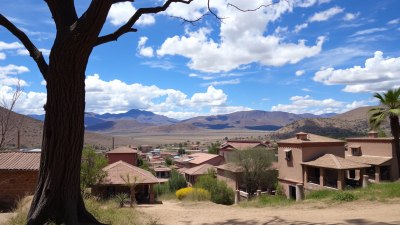Some Borders Cross Through the Middle of You
Explore the complexity of identity and borders in modern society in this thought-provoking article.

The concept of borders has been a critical topic throughout human history, serving both as a means of division and a pathway to unity. In today’s interconnected world, borders can no longer be seen merely as the lines that separate countries; they also represent cultural, emotional, and personal boundaries that individuals encounter daily. This article dives into how borders cross through the middle of us, defining who we are and influencing our life experiences.
Understanding borders starts with the recognition that they are not just geographical demarcations; they also encompass ideological and emotional aspects. These invisible boundaries often dictate the social construct of identity. Borders can manifest through various channels, including language, culture, nationality, and even personal relationships. The intersections of these borders create a tapestry of experiences that are rich and complex.
The Historical Context of Borders
Historically, borders have been established based on conflicts, treaties, and negotiations. They are shaped by the sociopolitical dynamics of their time, often cutting through communities and even families. The Berlin Wall serves as a stark example of a border that separated a nation, embodying the ideological divide of the Cold War era. Its erection not only split a city but also families and friendships, demonstrating how deeply borders can affect human lives.
Similarly, borders in the Middle East illustrate a complex tapestry of identity. The arbitrary lines drawn on maps often fail to reflect the intricate histories and cultural ties of the region’s people. This discordance leads to ongoing conflicts, resulting in large-scale displacement and a crisis of identity for millions. Understanding this history provides context for why borders are more than just physical lines; they are symbolic barriers that can encompass feelings of division and exclusion.
Cultural Borders: The Essence of Identity
Cultural borders define who we are, dictating our practices, beliefs, and social interactions. In multicultural societies, individuals often navigate multiple cultural borders simultaneously. For instance, in the United States, first-generation immigrants may experience a blend of their heritage with the dominant culture, creating an enriched, albeit conflicted, sense of identity. This phenomenon, often referred to as ‘hybrid identity,’ exemplifies how borders can intersect within an individual.
Additionally, cultural borders can result in both integration and segregation. The phenomenon of cultural appropriation, where elements of one culture are borrowed without understanding their significance, showcases the complexities of navigating these boundaries. The conversation surrounding appropriated practices emphasizes the need for awareness and respect towards cultural heritage, illustrating how borders can be both permissive and restrictive in nature.
The Psychological Impact of Borders
The emotional ramifications of borders can also have profound implications for personal identity. Many individuals struggle with the feeling of being ‘in-between’ when navigating multiple cultural identities, leading to a sense of displacement. Psychological studies indicate that this condition, often referred to as ‘multicultural identity conflict,’ can induce feelings of anxiety, confusion, and a diminished sense of belonging.
Moreover, borders can lead to cognitive dissonance, where conflicting beliefs and values co-exist, causing internal turmoil. For instance, a person may grow up in a society that emphasizes individualism, while also being influenced by collectivist values from their cultural heritage, leading to conflicting life choices and relationships. This dissonance highlights the powerful role of borders in shaping our thoughts and priorities.
Technology: Redefining Borders
The advent of the digital age has further blurred the traditional notions of borders. The internet has created virtual spaces where individuals can connect, share, and discuss ideas that transcend geographical boundaries. Social media platforms enable users to cultivate connections across the globe, sometimes forming communities that challenge the existing societal norms dictated by physical borders.
However, this technological interconnectedness does not come without its challenges. While digital platforms create opportunities for dialogue and exchange, they can also perpetuate divisions, fostering echo chambers and misinformation. The ways in which people interact across these virtual borders can reshape ideologies, sometimes reinforcing prejudices instead of dismantling them.
Globalization and Its Discontents
Globalization has transformed the landscape of borders by facilitating economic interdependence across nations. As trade, migration, and communication transcend traditional barriers, societies must grapple with the ramifications of increased interconnectedness. While globalization can foster cooperation and cultural exchange, it can also exacerbate inequalities and lead to a backlash against perceived threats to national identity.
The rise of populism in many countries is indicative of a growing resistance to the perceived erosion of cultural borders. This backlash often manifests in the form of stricter immigration policies and nationalistic rhetoric, as individuals rally to protect their cultural identities in the face of globalization. Understanding this dynamic is crucial for addressing the challenges that arise from the intersections of globalization and cultural identity.
The Role of Education in Bridging Borders
Education plays a pivotal role in addressing the complexities of borders. By fostering understanding and empathy, educational institutions can equip individuals with the tools necessary to navigate cultural differences. Programs that promote multicultural education can enhance global citizenship, encouraging students to appreciate diverse perspectives and challenge stereotypes.
Additionally, language education serves as a bridge across borders. Learning a new language can open doors to understanding different cultures, fostering an appreciation for diversity. The linguistic barrier often acts as a border in itself, rendering individuals isolated from broader conversations and experiences. Through language acquisition, individuals can transcend these barriers, enabling richer interactions and connections.
Personal Stories: Navigating Borders
Personal narratives illuminate the lived experiences of individuals navigating through various borders. Stories of immigrants highlight the struggles of adapting to new cultures while trying to maintain their heritage. These stories often reveal the emotional toll of acculturation and the push and pull of dual identities.
In one poignant account, a young woman recounts her experience of moving to a new country alone, grappling with feelings of isolation as she navigated the complexities of a new language and societal norms. Her narrative reflects the border that exists between her past and present, and the quest for belonging within an unfamiliar context.
Embracing the Crossroads
Ultimately, borders do not solely divide; they also create opportunities for growth and understanding. Embracing the complexities of identity and boundaries can lead to richer intercultural dialogues. As societies become increasingly interconnected, it is imperative to reflect on how borders intersect within us and shape our interactions with others.
Navigating through these borders may be challenging, but it opens the door to empathy, respect, and deeper connections across diverse landscapes. By acknowledging the multifaceted nature of borders, individuals can work towards building bridges instead of walls, fostering a harmonious coexistence that transcends divisions.











